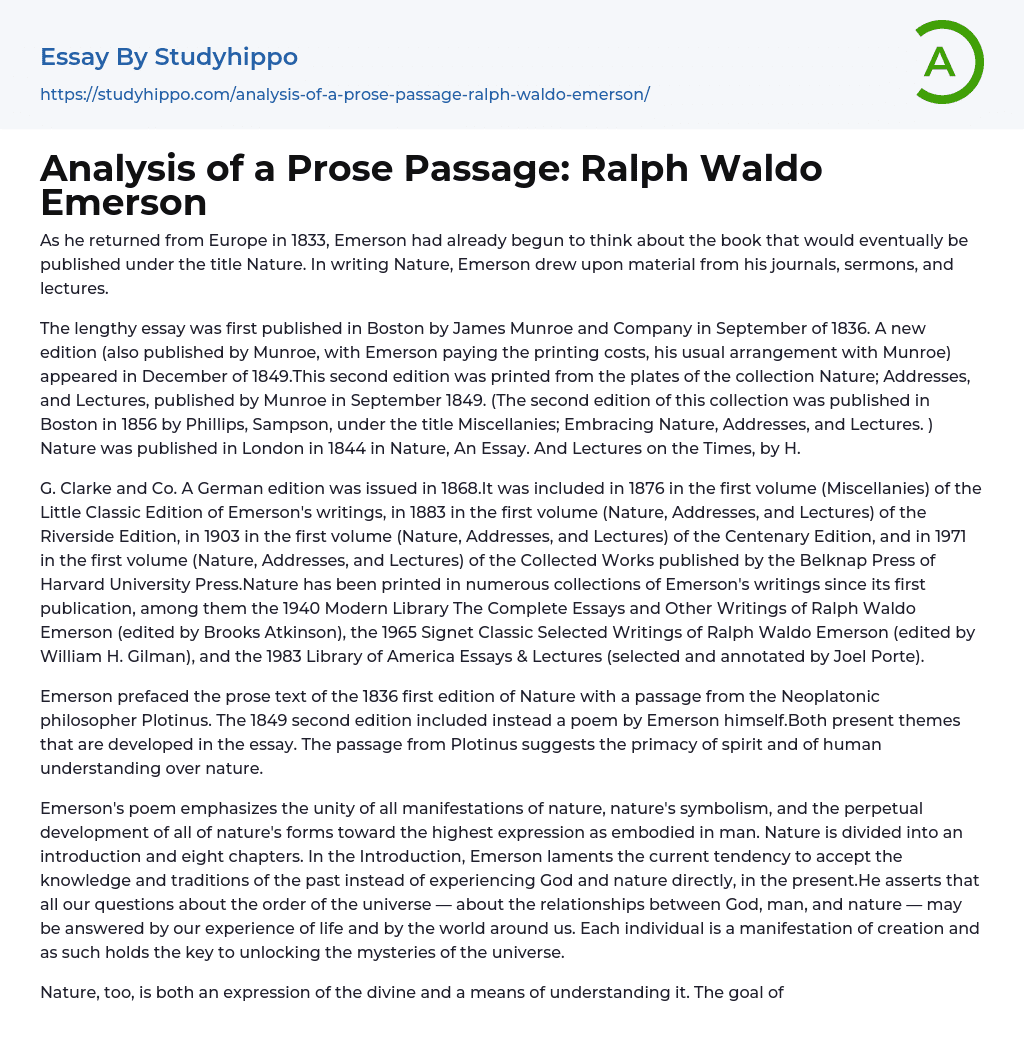

Analysis of a Prose Passage: Ralph Waldo Emerson Essay Example
As he returned from Europe in 1833, Emerson had already begun to think about the book that would eventually be published under the title Nature. In writing Nature, Emerson drew upon material from his journals, sermons, and lectures.
The lengthy essay was first published in Boston by James Munroe and Company in September of 1836. A new edition (also published by Munroe, with Emerson paying the printing costs, his usual arrangement with Munroe) appeared in December of 1849.This second edition was printed from the plates of the collection Nature; Addresses, and Lectures, published by Munroe in September 1849. (The second edition of this collection was published in Boston in 1856 by Phillips, Sampson, under the title Miscellanies; Embracing Nature, Addresses, and Lectures. ) Nature was published in London in 1844 in Nature, An Essay. And Lectures on
...the Times, by H.
G. Clarke and Co. A German edition was issued in 1868.It was included in 1876 in the first volume (Miscellanies) of the Little Classic Edition of Emerson's writings, in 1883 in the first volume (Nature, Addresses, and Lectures) of the Riverside Edition, in 1903 in the first volume (Nature, Addresses, and Lectures) of the Centenary Edition, and in 1971 in the first volume (Nature, Addresses, and Lectures) of the Collected Works published by the Belknap Press of Harvard University Press.Nature has been printed in numerous collections of Emerson's writings since its first publication, among them the 1940 Modern Library The Complete Essays and Other Writings of Ralph Waldo Emerson (edited by Brooks Atkinson), the 1965 Signet Classic Selected Writings of Ralph Waldo Emerson (edited by William H. Gilman), and the 1983 Library of America
Essays & Lectures (selected and annotated by Joel Porte).
Emerson prefaced the prose text of the 1836 first edition of Nature with a passage from the Neoplatonic philosopher Plotinus. The 1849 second edition included instead a poem by Emerson himself.Both present themes that are developed in the essay. The passage from Plotinus suggests the primacy of spirit and of human understanding over nature.
Emerson's poem emphasizes the unity of all manifestations of nature, nature's symbolism, and the perpetual development of all of nature's forms toward the highest expression as embodied in man. Nature is divided into an introduction and eight chapters. In the Introduction, Emerson laments the current tendency to accept the knowledge and traditions of the past instead of experiencing God and nature directly, in the present.He asserts that all our questions about the order of the universe — about the relationships between God, man, and nature — may be answered by our experience of life and by the world around us. Each individual is a manifestation of creation and as such holds the key to unlocking the mysteries of the universe.
Nature, too, is both an expression of the divine and a means of understanding it. The goal of science is to provide a theory of nature, but man has not yet attained a truth broad enough to comprehend all of nature's forms and phenomena.Emerson identifies nature and spirit as the components of the universe. He defines nature (the "NOT ME") as everything separate from the inner individual — nature, art, other men, our own bodies. In common usage, nature refers to the material world unchanged by man. Art is nature in combination
with the will of man.
Emerson explains that he will use the word "nature" in both its common and its philosophical meanings in the essay. At the beginning of Chapter I, Emerson describes true solitude as going out into nature and leaving behind all preoccupying activities as well as society.When a man gazes at the stars, he becomes aware of his own separateness from the material world. The stars were made to allow him to perceive the "perpetual presence of the sublime.
" Visible every night, they demonstrate that God is ever-present. They never lose their power to move us. We retain our original sense of wonder even when viewing familiar aspects of nature anew. Emerson discusses the poetical approach to nature — the perception of the encompassing whole made up of many individual components. Our delight in the landscape, which is made up of many particular forms, provides an example of this integrated vision.
- Oxygen essays
- Atmosphere essays
- Coral Reef essays
- Desert essays
- Earth essays
- Ocean essays
- Lake essays
- Sea essays
- Biodiversity essays
- Natural Environment essays
- Forest essays
- Soil essays
- Water essays
- Rainbow essays
- Ecosystem essays
- Volcano essays
- Wind essays
- Forestry essays
- Bottled Water essays
- Air Pollution essays
- Carbon Dioxide essays
- Climate essays
- Deforestation essays
- Ecology essays
- Endangered Species essays
- Environmental Issues essays
- Environmental Protection essays
- flood essays
- Greenhouse Gas essays
- Hurricane essays
- Nature essays
- Pollution essays
- Renewable Energy essays
- Sustainability essays
- Tornado essays
- Traffic essays
- Tsunami essays
- Water Pollution essays
- Consciousness essays
- Intelligence essays
- Mindset essays
- Perception essays
- Problem Solving essays
- Resilience essays
- Aldous Huxley essays
- Alice Walker essays
- Amy tan essays
- Anne Bradstreet essays
- Anton Chekhov essays
- Arthur Miller essays



